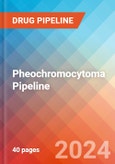This “Pheochromocytoma - Pipeline Insight, 2024,” report provides comprehensive insights about 4+ companies and 4+ pipeline drugs in Pheochromocytoma pipeline landscape. It covers the pipeline drug profiles, including clinical and nonclinical stage products. It also covers the therapeutics assessment by product type, stage, route of administration, and molecule type. It further highlights the inactive pipeline products in this space.
Geography Covered
- Global coverage
Pheochromocytoma Understanding
Pheochromocytoma: Overview
Pheochromocytoma is a rare type of tumor that arises from certain cells known as chromaffin cells, which produce hormones necessary for the body to function properly. Most pheochromocytomas originate in one of the two adrenal glands located above the kidneys in the back of the upper abdomen. Most chromaffin cells are found in the adrenal gland's inner layer, which is known as the adrenal medulla. In some cases, individuals with a pheochromocytoma may not develop symptoms (asymptomatic). High blood pressure (hypertension) is the most common finding associated with pheochromocytomas. High blood pressure may be sustained or may come and go.
Pheochromocytoma - Pipeline Insight, 2024 report outlays comprehensive insights of present scenario and growth prospects across the indication. A detailed picture of the Pheochromocytoma pipeline landscape is provided which includes the disease overview and Pheochromocytoma treatment guidelines. The assessment part of the report embraces, in depth Pheochromocytoma commercial assessment and clinical assessment of the pipeline products under development. In the report, detailed description of the drug is given which includes mechanism of action of the drug, clinical studies, NDA approvals (if any), and product development activities comprising the technology, Pheochromocytoma collaborations, licensing, mergers and acquisition, funding, designations and other product related details.
Report Highlights
- The companies and academics are working to assess challenges and seek opportunities that could influence Pheochromocytoma R&D. The therapies under development are focused on novel approaches to treat/improve Pheochromocytoma.
Pheochromocytoma Emerging Drugs Chapters
This segment of the Pheochromocytoma report encloses its detailed analysis of various drugs in different stages of clinical development, including phase II, I, preclinical and Discovery. It also helps to understand clinical trial details, expressive pharmacological action, agreements and collaborations, and the latest news and press releases.
Pheochromocytoma Emerging Drugs
Atezolizumab: GenentechAtezolizumab is a humanized monoclonal antibody immune checkpoint inhibitor that selectively binds to PD-L1 to stop the interaction between PD-1 and B7. 1 (ie, CD80 receptors). The drug is in phase 2 of clinical development for the treatment of patients with Pheochromocytoma.
Cabozantinib: ExelixisCabozantinib is a small molecule therapy that inhibits the activity of tyrosine kinases including VEGF receptors, MET, AXL, and RET. These receptor tyrosine kinases are involved in both normal cellular function and in pathologic processes such as oncogenesis, metastasis, tumor angiogenesis and maintenance of the tumor microenvironment. The drug is in phase 2 of clinical development for the treatment of patients with Pheochromocytoma.
Pheochromocytoma: Therapeutic Assessment
This segment of the report provides insights about the different Pheochromocytoma drugs segregated based on following parameters that define the scope of the report, such as:
Major Players in Pheochromocytoma
There are approx. 4+ key companies which are developing the therapies for Pheochromocytoma. The companies which have their Pheochromocytoma drug candidates in the most advanced stage, i.e. phase II include, Genentech.
Phases
This report covers around 4+ products under different phases of clinical development like
- Late stage products (Phase III)
- Mid-stage products (Phase II)
- Early-stage product (Phase I) along with the details of
- Pre-clinical and Discovery stage candidates
- Discontinued & Inactive candidates
Route of Administration
Pheochromocytoma pipeline report provides the therapeutic assessment of the pipeline drugs by the Route of Administration. Products have been categorized under various ROAs such as
- Oral
- Parenteral
- intravitreal
- Subretinal
- Topical.
Molecule Type
Products have been categorized under various Molecule types such as
- Monoclonal Antibody
- Peptides
- Polymer
- Small molecule
- Gene therapy
Product Type
Drugs have been categorized under various product types like Mono, Combination and Mono/Combination.
Pheochromocytoma: Pipeline Development Activities
The report provides insights into different therapeutic candidates in phase II, I, preclinical and discovery stage. It also analyses Pheochromocytoma therapeutic drugs key players involved in developing key drugs.
Pipeline Development Activities
The report covers the detailed information of collaborations, acquisition and merger, licensing along with a thorough therapeutic assessment of emerging Pheochromocytoma drugs.
Pheochromocytoma Report Insights
- Pheochromocytoma Pipeline Analysis
- Therapeutic Assessment
- Unmet Needs
- Impact of Drugs
Pheochromocytoma Report Assessment
- Pipeline Product Profiles
- Therapeutic Assessment
- Pipeline Assessment
- Inactive drugs assessment
- Unmet Needs
Key Questions
Current Treatment Scenario and Emerging Therapies:
- How many companies are developing Pheochromocytoma drugs?
- How many Pheochromocytoma drugs are developed by each company?
- How many emerging drugs are in mid-stage, and late-stage of development for the treatment of Pheochromocytoma?
- What are the key collaborations (Industry-Industry, Industry-Academia), Mergers and acquisitions, licensing activities related to the Pheochromocytoma therapeutics?
- What are the recent trends, drug types and novel technologies developed to overcome the limitation of existing therapies?
- What are the clinical studies going on for Pheochromocytoma and their status?
- What are the key designations that have been granted to the emerging drugs?
Key Players
- Genentech
- Exelixis
- Advanced Accelerator Applications
- Enterome
- FUJIFILM Toyama Chemical
- Ipsen
- Pfizer
- Astex Pharmaceuticals
Key Products
- Atezolizumab
- Cabozantinib
- Lutetium-177 oxodotreotide
- EO2401
- Iobenguane I-131
- Lanreotide
- Axitinib
- Guadecitabine
Table of Contents
IntroductionExecutive Summary
Companies Mentioned (Partial List)
A selection of companies mentioned in this report includes, but is not limited to:
- Genentech
- Exelixis
- Advanced Accelerator Applications
- Enterome
- FUJIFILM Toyama Chemical
- Ipsen
- Pfizer
- Astex Pharmaceuticals








